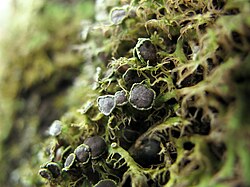Biology:Anaptychia
| Anaptychia | |
|---|---|

| |
| Apothecia of Anaptychia ciliaris | |
| Scientific classification | |
| Domain: | Eukaryota |
| Kingdom: | Fungi |
| Division: | Ascomycota |
| Class: | Lecanoromycetes |
| Order: | Caliciales |
| Family: | Physciaceae |
| Genus: | Anaptychia Körb. (1848) |
| Type species | |
| Anaptychia ciliaris (L.) Körb. (1853)
| |
| Species | |
|
A. ciliaris | |
| Synonyms[1] | |
| |
Anaptychia is a genus of lichen-forming fungi in the family Physciaceae.[2] Anaptychia species have brown, thin-walled spores with a single septum, and a prosoplechtenchymatous upper cortex.[3]
Taxonomy
The genus was circumscribed by German lichenologist Gustav Wilhelm Körber in his 1848 work Grundriss der Kryptogamen-Kunde.[4] In his 1962 monograph on the genus, Syo Kurokawa included 88 species.[5] A few years later, Josef Poelt thought the genus should be divided into two genera – Anaptychia and Heterodermia – based largely on differences in spore structure.[6] William Culberson supported this opinion, emphasizing the presence of distinct chemical characteristics between the two groups.[7]
Some species of Anaptychia were transferred to the genus Kurokawia, newly circumscribed in 2021.[8]
Description
Anaptychia lichens have a thallus that ranges from leaf-like (foliose) to slightly shrubby (somewhat fruticose) in nature. These can be of small to medium size, with a degree of attachment that ranges from moderate to quite loose. In terms of colouration, they vary from a muted white or grey to a darker brown shade. The upper surface of the thallus can display a variety of features. In some species, it remains completely smooth, while others might exhibit a light dusting known as pruina. Still, others might have a soft covering of fine, cortex-derived hairs or larger tapering hairs, especially closer to the edges of the lobes. There might also be the presence of marginal hair-like projections, referred to as cilia. The lichen's lower surface can be of a light hue which may darken over time, and it can range from having a sparse to a dense presence of root-like structures known as rhizines. These rhizines might be of a simple (unbranched) form, split into a few branches, or exhibit intricate branching.[9]
The uppermost protective layer, or cortex, displays a patterned cellular arrangement of outward-facing, thick-walled hyphae. In contrast, the lower cortex can either be absent or display a similar arrangement, but it might sometimes appear less structured and not distinctly separate from the inner fleshy layer, known as the medulla.[9]
Anaptychia bears reproductive structures known as apothecia, which are encircled by a thallus-derived boundary. Inside these apothecia, there are sac-like structures that typically contain eight spores. These spores resemble those of the Physconia type, are brown, and are partitioned once, measuring in the range of 25–52 μm in length and 13–24 μm in width. Another kind of reproductive structure, the pycnidia, appear on the thallus surface and are darkened and sunken. The pycnidia contain spore-like conidia that are rod-shaped to slightly cylindrical, with sizes ranging between 3.5–6 μm in length and up to 6.1 μm in width.[9]
Species
(As of September 2023), Species Fungorum accepts 5 species of Anaptychia.[10]
- Anaptychia ciliaris (L.) Körb. ex A.Massal. (1853)
- Anaptychia crinalis (Schleich. ex Schaer.) Vězda ex J.Nowak (1993)
- Anaptychia desertorum (Rupr.) Poelt (1969)
- Anaptychia elbursiana (Szatala) Poelt (1966)
- Anaptychia ethiopica Swinscow & Krog (1976)[11]
- Anaptychia isidiza Kurok. (1962)
- Anaptychia nevadensis Hollinger, Noell & S.D.Leav. (2022)[12] – western North America
- Anaptychia roemerioides Hollinger, Noell & S.D.Leav. (2022)[12] – western North America
References
- ↑ "Synonymy: Anaptychia Körb.". Species Fungorum. http://www.speciesfungorum.org/Names/SynSpecies.asp?RecordID=186. Retrieved 19 August 2020.
- ↑ Cite error: Invalid
<ref>tag; no text was provided for refs namedWijayawardene et al. 2020 - ↑ Lohtander, Katileena; Ahti, Teuvo; Stenroos, Soili; Urbanavichus, Gennadii (2008). "Is Anaptychia monophyletic? A phylogenetic study based on nuclear and mitochondrial genes". Annales Botanici Fennici 45 (1): 55–60. doi:10.5735/085.045.0106.
- ↑ Körber, Gustav Wihlem (1848). Grundriss der Kryptogamen-Kunde. Breslau: Ed. Trewendt. p. 87. https://www.biodiversitylibrary.org/page/54484034.
- ↑ Kurokawa, Syo (1962). A Monograph of the Genus Anaptychia. Weinheim: J. Cramer.
- ↑ Poelt, Josef (1965). "Zur Systematik der Flechtenfamilie Physciaceae" (in de). Nova Hedwigia 9: 21–32.
- ↑ Culberson, William Louis (1966). "Chemistry and taxonomy of the lichen genera Heterodermia and Anaptychia in the Carolinas". The Bryologist 69 (4): 472–487. doi:10.2307/3240580.
- ↑ Kondratyuk, S.Y.; Lőkös, L.; Kärnefelt, I.; Thell, A.; Jeong, M.-H.; Oh, S.-O.; Kondratiuk, A.S.; Farkas, E. et al. (2021). "Contributions to molecular phylogeny of lichen-forming fungi 2. Review of current monophyletic branches of the family Physciaceae". Acta Botanica Hungarica 63 (3–4): 351–390. doi:10.1556/034.63.2021.3-4.8. http://real.mtak.hu/143270/1/article-p351.pdf.
- ↑ 9.0 9.1 9.2 Esslinger, Theodore L. (2007). "A synopsis of the North American species of Anaptychia (Physciaceae)". The Bryologist 110 (4): 788–797. doi:10.1639/0007-2745(2007)110[788:asotna2.0.co;2].
- ↑ "Anaptychia". Species 2000: Naturalis, Leiden, the Netherlands. https://www.catalogueoflife.org/data/taxon/V6V.
- ↑ Cite error: Invalid
<ref>tag; no text was provided for refs namedSwinscow & Krog 1976 - ↑ 12.0 12.1 Hollinger, Jason; Noell, Nastassja; Gasparyan, Arsen; Rockefeller, Alan; Leavitt, Steven D. (2022). "Two new species of Anaptychia (Physciaceae) from western North America, with notes on the other species of section Protoanaptychia". The Bryologist 125 (4): 571–601. doi:10.1639/0007-2745-125.4.571.
Wikidata ☰ Q4751597 entry
 |

